#important of millets
Text
I could fix the Anatomy house, btw
#if you don't know what I'm talking about please play Anatomy by Kitty Horrorshow. it's great.#anyway here's how i'd fix her:#1. i'd tell her this whole plan first so she can eat me if she doesn't like it. (consent is important!)#2. together we're gonna prop some of her windows permanently open.#3. then we're gonna replace her sinks & toilets with flat pans and shallow fountains.#4. i'm gonna plant window boxes full of sorghum and millet and peas and seeds#5. interior decorating! she needs to blunt all the sharp objects and maximise flat horizontal surfaces#6. DONE! I give it a week before a metric fuckton of pigeons move in and never leave. she'll never be lonely again.#also if any cringe humans try to bother her pigeons she can eat them!
3 notes
·
View notes
Text
Green Millet Manufacturer in India: Euro Sun India's Commitment to Quality Agriculture
In the heartland of India, where agriculture is not just a vocation but a way of life, Euro Sun India has emerged as a leading Green Millet Manufacturer in India. Renowned for its commitment to quality and sustainable practices, Euro Sun India has become a key player in the production and distribution of Green Millets. Let's explore the various facets of Euro Sun India's role as a Supplier, Exporter, Wholesaler, and Trader, with a focus on its impact in Rajasthan.

Green Millet Supplier in India: Sowing the Seeds of Quality
As a Green Millet Supplier in India, Euro Sun India has set a benchmark for quality in the agricultural sector. The company takes pride in its meticulous approach to cultivation, ensuring that the millets produced are of the highest standard. Euro Sun India's commitment to quality begins at the grassroots level, with a focus on sustainable farming practices that not only yield superior produce but also contribute to the overall well-being of the environment.
Green Millet Exporter in India: Nurturing Global Health
Euro Sun India has expanded its reach beyond national borders, establishing itself as a reputable Green Millet Exporter. Through strategic alliances and a dedication to meeting international quality standards, the company has successfully penetrated global markets. By exporting premium Green Millets, Euro Sun India contributes to the worldwide demand for nutritious grains, fostering global health and well-being.
Green Millet Wholesaler in Rajasthan: Nourishing the State's Heartland
In the arid landscapes of Rajasthan, Euro Sun India plays a crucial role as a Green Millet Wholeseller in Rajsthan. The company understands the nutritional needs of the region and ensures that its produce reaches every corner of the state. Euro Sun India's extensive distribution network in Rajasthan has not only made high-quality Green Millets accessible but has also contributed to the health and prosperity of the local population.
Green Millet Trader in Rajasthan: Bridging Farmers and Consumers
Functioning as a Green Millet Trader in Rajsthan, Euro Sun India acts as a bridge between farmers and consumers. The company's fair trade practices ensure that farmers receive fair compensation for their hard work, fostering a sustainable and mutually beneficial relationship. Euro Sun India's role as a trader is not just about facilitating transactions; it's about building a community that values and respects the contributions of every player in the agricultural ecosystem.
Euro Sun India's Sustainable Approach to Agriculture
At the core of Euro Sun India's success is its commitment to sustainable agriculture. The company recognizes the importance of preserving the environment and actively invests in eco-friendly farming practices. By integrating modern technology with traditional wisdom, Euro Sun India maximizes yield while minimizing the ecological footprint. This sustainable approach not only ensures the longevity of the business but also contributes to the overall health of the planet.
The Nutritional Value of Green Millets: A Healthier Tomorrow
Consumers today are increasingly aware of the nutritional benefits of Green Millets. Euro Sun India takes pride in contributing to the well-being of individuals by providing a product that is not just tasty but also highly nutritious. Packed with essential nutrients, Green Millets offer a gluten-free, fiber-rich alternative that supports digestive health, regulates blood sugar, and promotes overall wellness.
Conclusion: Euro Sun India – Cultivating a Healthier Future
In the realm of Green Millet production, Euro Sun India stands as a symbol of excellence, sustainability, and quality. Whether as a Supplier, Exporter, Wholesaler, or Trader, the company's impact is felt across the agricultural landscape of India, particularly in Rajasthan. Euro Sun India's commitment to quality, sustainability, and community building makes it a key player in the quest for a healthier and more nourished future.
For superior quality Green Millets and a commitment to a healthier tomorrow, choose Euro Sun India – your trusted partner in agriculture.
Green Millet Supplier in India, Green Millet Exporter in India, Green Millet Wholesaler in Rajasthan, Green Millet Trader in Rajasthan – Euro Sun India, cultivating excellence from farm to table.
0 notes
Text
[Traditional Chinese Festival] Customs of 臘八節(Laba Festival) in China.Eng Sub
Today(January 18, 2024) is the traditional Chinese festival,臘八節 Laba Festival.Let’s learn about some interesting traditions and customs about this festival.
【About 臘八節(Laba Festival)】
Laba Festival (Chinese:臘八節) is a traditional Chinese holiday celebrated on the eighth day of the month of La (or Layue 臘月), the twelfth month of the Chinese calendar. It is the beginning of the Chinese New Year period. It is customary on this day to eat Laba congee.
Laba Festival was not on a fixed day until the Southern and Northern dynasties, when it was influenced by Buddhism and was fixed on the eighth day of twelfth month, which was also the enlightenment day of the Buddha. Therefore, many customs of the Laba Festival are related to Buddhism.
The Laba Festival's name represents its date on the Chinese calendar. La is the name of the twelfth and final month, and ba means "eight/八". In ancient China, the "eight/八" referred to making sacrifices to eight gods at the end of the year.
In its original form, the festival was celebrated by making sacrifices to gods and ancestors to wish for good fortune, health, safety, and a good harvest in the new year. The word la originally referred to these sacrifices.
After Buddhism spread to China during the first century CE, the festival was used as commemoration of Gautama Buddha's enlightenment.It was given a fixed date (the eighth day of the twelfth month) during the Northern and Southern dynasties.
【Customs of 臘八節/Laba Festival?】
Laba congee/臘八粥

Traditionally, the consumption of Laba congee is an important element of the festival. There are multiple legendary accounts of the dish's origins. One story says that it originated in the Song dynasty with Buddhist monasteries giving congee to people in honor of the story that Sakyamuni (Gautama Buddha) reached enlightenment on the eighth day of the twelfth month after eating congee.
Laba congee or Laba porridge (臘八粥; Làbāzhōu) is very popular in many places in China. Different kinds of rice, beans, nuts and dried fruits are the main ingredients. People believe that it's good for health in the winter.
It is also known as "eight-treasure congee" (八宝粥; Bā bǎo zhōu)and is usually made with eight or more ingredients, representing good luck. Eight is a lucky number in China, and the ba in Laba also means eight.
There are many variations of Laba congee in different regions of China. Ingredients can include mixed grains, such as rice, millet, and barley; beans and nuts such as mung beans, azuki beans, lotus seeds, peanuts, walnuts, and chestnuts; dried fruit such as red dates, longan, raisins, and goji berries; and other ingredients such as vegetables and meat.
2.Laba garlic/臘八蒜
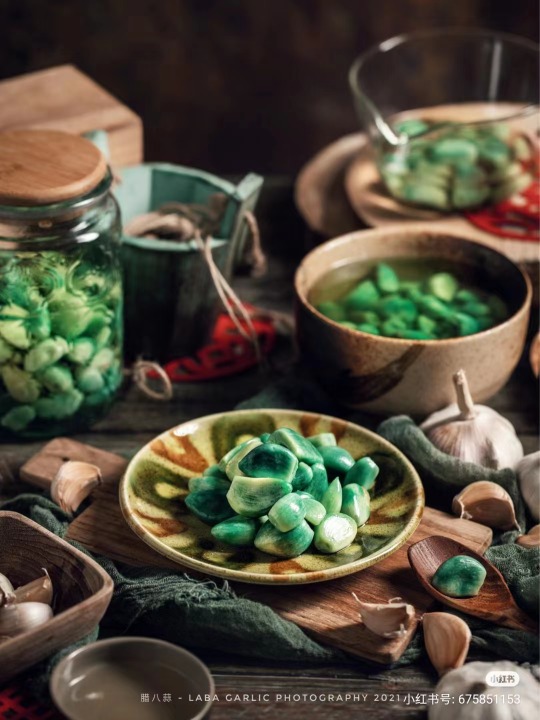
Another Laba food is Laba garlic, which is particularly popular in northern China.Garlic in Chinese (蒜; suàn) has the same pronunciation as calculate (算; suàn), and it is said that on the Laba Festival businesses should balance their books and calculate their revenues and expenditures for the year.Laba garlic is made by soaking garlic in vinegar. Laba garlic is soaked in vinegar from the Laba Festival until Chinese New Year. The garlic and vinegar are then used alongside Chinese dumplings (jiaozi) around Chinese New Year.
————————
🧚🏻Model/Makeup:@曾嚼子&@兔狲猫眠眠
📸 Photo:@逸群闲余
🔗 Xiaohongshu:http://xhslink.com/zlF8Hz
————————
#chinese hanfu#hanfu#Traditional Chinese Festival#臘八節 Laba Festival#chinese culture#chinese customs#chinese history#hanfu accessories#chinese food#china#chinese new year#song dynasty
197 notes
·
View notes
Text
Eating Well
If you are someone who struggles to figure out what to eat, this post may help.
There is a lot of information out there about eating well. It's important to know it's not as complicated as most guides try to make it. The following is a simple way of looking at food adapted from David Werner's Where There Is No Doctor:
You need a main food, or foods. A "Main Food" is one or more starch bases, like pasta/noodles, bread/tortilla/biscuits, hominy, rice, potatoes, taro, millet, barley, or another grain or starchy tuber.
These are usually cheap and should make up a majority of your calories. They often also provide an amount of protein, vitamins and minerals.
However, living on starchy bases alone is not adequate. To them, you need to add at least one or two each of "Go Foods", "Grow Foods" and "Glow Foods" every day.
"Go Foods" are energy foods. They are things like oils, fats, peanuts, other nuts, oily seeds (like sesame and sunflower), and sugars (like granulated sugar, honey, maple syrup, and fruit juices). Eat more of these if you are doing heavy work. They can also replace some of your Main Food, though they are often somewhat more expensive.
"Grow Foods" are foods that build muscle and other body tissues and heal injuries. They include animal foods (like meat, eggs, milk, and fish), legumes (beans, peas, peanuts, and lentils), and seeds (pumpkin, sesame, sunflower, melon, etc...).
"Glow Foods" are foods that contain a lot of vitamins and minerals. These include dark green leafy vegetables (spinach, kale, collards, turnip greens, radish greens, etc...), orange vegetables (carrots, pumpkins, sweet potatoes, tomatoes, peppers, winter squash of any kind, etc...), fruits (apples, pears, berries, quince, etc...) and other vegetables (turnips, radishes, summer squash, onions, cabbage, etc...), herbs and spices (chili powder, garlic, cumin, thyme, oregano, sage, cinnamon, etc...).
Example meals (each meal does not need to contain all types of foods, as long as someone is eating some of each every day):
A rice bowl (Main) with vegetable (Glow) and bean (Grow) curry (Glow).
Oatmeal (Main) with whole or coconut milk (Go, Grow) and berries (Glow)
Spaghetti (Main) with tomato sauce (Glow) and meatballs (Grow)
Tapioca pudding (Main, Grow, Go) with cinnamon and nutmeg (Glow)
Farrow (Main) with stewed tomatoes (Glow) and olive oil (Go)
Zucchini boats (Glow) with black beans (Grow), rice (Main) and cheese (Go, Grow)
Baked potato (Main) with broccoli (Glow) and cheese (Go, Grow)
Potato (Main) and spinach (Glow) curry (Glow)
Whole fat yogurt (Grow, Go), granola (Main, Go), and berries (Glow)
Peanut butter (Go, Grow) and jam (Go, Glow) on toast (Main)
208 notes
·
View notes
Note
Sorry if my question was uncomfortable, but I'm a foreigner and would like to understand more about the "feud" between Greece and North Macedonia. I've seen (heated) discussions between Greeks and Macedonians about culture, but I don't know much about the context. Again, sorry if the question is uncomfortable or insensitive.
I think this Geography Now! video does a good job of explaining the controversy. Basically, the Greek position is that since Slavs came a thousand years after Alexander in the area, and the culture and language of North Macedonians are largely Slavic it's illogical for them to name their country after a Hellenistic kingdom and claim many Greek figures, and also Alexander the Great, as people from their culture.
For clarification, Alexander the Great was certainly Greek and he spoke the Macedonian dialect of Greek which was Doric (for reference the Spartans also spoke the Doric dialect). When North Macedonians say "he was Macedonian" they mean he was from their culture and he spoke their language, and he wasn't Greek.
North Macedonian history tends to confuse the administrative regions with culture and ethnicity because it's convenient to them. It doesn't matter if Kyrillos and Methodios were two Greek brothers from Thessaloniki. To N. Macedonians, because these two brothers were in a region that was occasionally the administrative region of Macedonia, they were "Macedonians", hence "from North Macedonia". To them it doesn't matter that Alexander's birthplace and all important cities of the Hellenistic Macedonian Kingdom are in Greece.
What is crucial to understand about this controversy is that Macedonia for a long, long time, was basically "a geographical region of many mountains". The Greek word Μακεδονία literally means "Mountainous Region", and because it's kind of a distinct region it was a district on its own many times. That's an approximation of the limits of "Macedonia" as a geographical region with distinct characteristics.

Below is the ancient Greek kingdom of Macedonia. However, the people who are now residents of N. Macedonia won't be here for another thousand years!
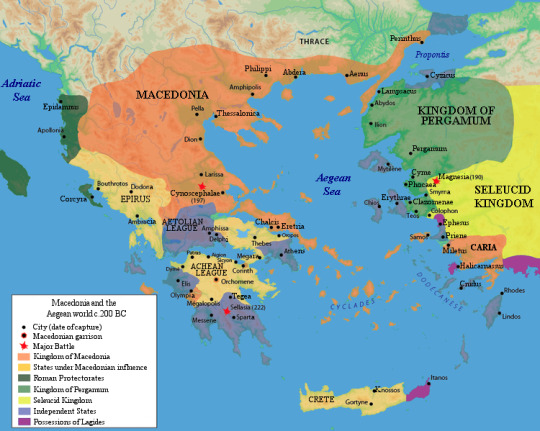
The guy in the video says the Macedonian kingdom expanded, but then he doesn't say that it was separated into more kingdoms for better governance, and one of those kingdoms was this controversial region (in Green) which is now part of Greece and North Macedonia. (Slavs were still not in the area)

When Romans conquered these kingdoms they also separated the area into administrative regions. The province of Macedonia within the Roman Empire, circa 125 (Slavs were still not in the area):

Later administrative departments of Roman empire (Slavs were still not in the area). In fact, "Provincia Macedoniae" changed almost at the time the Slavs arrived, in the 7th century.
Within the Eastern Roman Empire there was later separation into Themata, but now the department of Macedonia was moved to the West, occasionally including parts of the region where N. Macedonia is today. (Slavs in the area after 7th c. ACE)
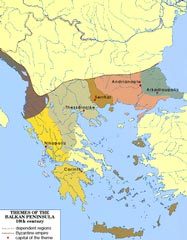
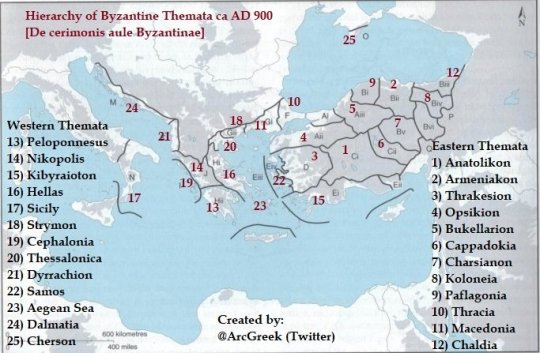

Theeeen came the Turks, and separated the regions differently. Now everyone, Turks, Greeks, Slavs, Hebrews and whoever else lived in that region, are all part of the same "millet", the Rum Millet. "Macedonia" wasn't an administrative area then.

In the 19th century, Turks and Slavs were the majority in the region of Macedonia, with Greeks coming third population-wise, and Hebrews also having very large communities.
(Greeks might not like this fact, or they may ignore it completely, but if you open actual historical books and maps, you'll see the demographics. We have censuses from that era. I learned the old Slavic and Turkic names that villages and places in my region had. There's also a reason Kemal Ataturk's mother wrote to him "They took our Salonik" when Greeks reclaimed the city after 600 years. We can still love our country and appreciate our history, without erasing parts of it.)
In 1912, the largest part of the region of Macedonia was claimed by Greeks. In time more Greeks came to it as immigrants from Anatolia and other Greek regions, shifting the population in such a way that Greeks were now the majority. (North Macedonia still doesn't exist as a country)
In 1991, when the country of North Macedonia was created, Greece already had an administrative region of Macedonia which covered most of the Macedonian geographical area, also the ancient Greek cities of the kingdom, and the emblem of Greek Macedonia was the ancient Greek Macedonian star. The Vergina Star, and the ancient Greek city of Vergina is also in Greek ground today. (Our Emblem and Flag)
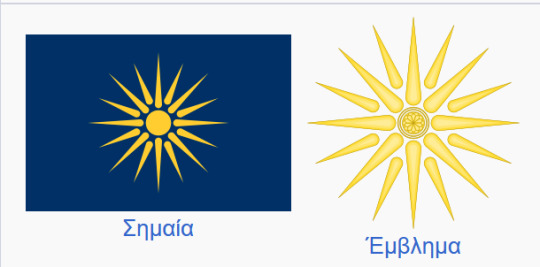
So you can imagine it came as a shock to Greeks when a newly founded country used not only their symbols, but also distinctly Greek symbols. People who are now residents of N. Macedonia lived in the geographical region that a few centuries ago was also "Macedonia" in the administrative sense, so I get where they're coming from. However, when culture gets appropriated, when the culture of important ethnically Greek figures is erased, when Greek words are claimed to be "Macedonian" all of a sudden since 1991, things get tense.
It's a political matter, as the video says. People from the two countries usually have normal interactions if the matter doesn't come up. And I don't think there's hate between the simple people.
#I am not in the mood for a debate I just wanted to explain stuff#make your own post if you want to let off some steam against Greeks :P#answered
60 notes
·
View notes
Text
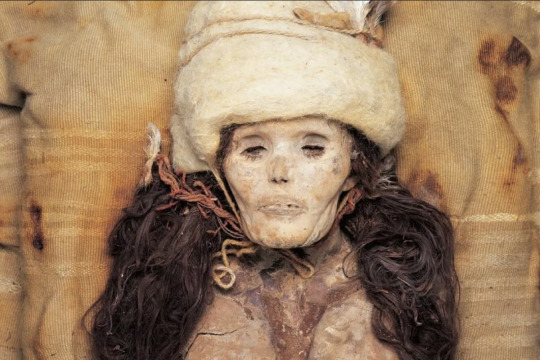
The Princess of Xiaohe (Chinese: 小河公主) or Little River Princess was found in 2003 at Xiaohe Cemetery in Lop Nur, Xinjiang. She is also known as M11 for the tomb she was found in. She was buried around 3,800 years ago. Furthermore, she was named the Princess of Xiaohe due to her state of preservation and beauty, not her social status; there is no reason to believe she was any more important than the other mummies buried in the complex.
The Princess has blonde hair and long eyelashes, with some facial features more similar to Indo-Europeans, such as high cheekbones and pale skin. She seems to be smiling slightly. She was 152 centimetres tall. Chunks of cheese were found on her neck and chest, possibly as food for the afterlife. Her body was not embalmed before death, but mummified naturally due to the climate and burial method.
“Despite being genetically isolated, the Bronze Age peoples of the Tarim Basin were remarkably culturally cosmopolitan – they built their cuisine around wheat and dairy from West Asia, millet from East Asia and medicinal plants like Ephedra from Central Asia,” said senior author Christina Warinner, an associate professor of anthropology at Harvard University.
The Tarim Basin mummies in what is now southern Xinjiang were once thought to be Indo-European-speaking migrants from the West. Some thought that their ancestors migrated from what became southern Siberia, northern Afghanistan or the Central Asian mountains.
“The identity of the earliest inhabitants of Xinjiang, in the heart of inner Asia, and the languages that they spoke have long been debated and remain contentious,” wrote the team of 34 researchers from China, Germany, South Korea and the United States in peer-reviewed journal Nature on Wednesday.
377 notes
·
View notes
Text


Which vitamins will help with weightloss?
✎﹏﹏﹏﹏﹏﹏﹏﹏﹏﹏﹏﹏﹏﹏﹏﹏
1. vitamin A 🥕📙
helps increase efficiency, accelerates metabolism and helps to recover quickly after exertion.
(products that contain vitamin A: fruits and vegetables of red and orange colors)
2. vitamin D3 📘🐾
vitamin D helps to lose weight by participating in metabolism. If you're not losing weight despite regular exercise, healthy sleep, and a healthy diet, you may not be getting enough of this substance.
(foods: fatty fish, potatoes, sunflower oil, oats, parsley, nettles. It is best to take as a vitamin supplement)
3. Thiamin or vitamin B1 🥣📔
Vitamin B1 (scientifically known as thiamine) is very important for carbohydrate metabolism. B1 deficiency is the cause of increased appetite, provocation of overeating and, as a result, excessive weight.
(products which contain: dark cereals, beans, red meat, liver, bread made from coarse flour)
4. Potassium 🫐🐾
Helps maintain skin elasticity and prevent cellulite during weight loss. Removes toxins and promotes better functioning of the stomach.
(foods: bananas, nuts, spinach, and especially potassium-rich black currants)
5. Chrome 🥦📗
interacts with insulin, helping the body to absorb glucose better. The more chromium in the body, the less the craving for sweets and the smaller is your appetite in general.
(found in Brazil nuts and hazelnuts, buckwheat, millet, cheese, onions, beans, potatoes, broccoli, cauliflower and Brussels sprouts)
#dieta ana#anoresick#ana inspiration#anoreksik#anorexigenic#ana trigger#anorexies#anorexcya#anor3c1a#an0rec1a#an0r3c1a#weight loss motivation#weight loss diet#weight loss#skinnyspø#skinnyyy#skinnytumbler#thin$p0#thin$po#thinspø#th1nnsp0#th1nspø#th1n$pø#th1gh g@p#th1nsp1ration#info post#ana bllog#motivation#tw ed diet#calories
56 notes
·
View notes
Text
youtube
Made a little audio drama thing out of a script by the lovely @sexygoddessdawgy where you pretend that Laios is nerding out to you about monsters for five and a half minutes.
Script under cut!
Laois (excited): I never would’ve thought someone would sign up for a lecture of mine! Of course I'd be happy to show you the ropes! Here, take a seat.
(Sounds of a book being open, pages flipping)
Laois: *ahem* Welcome to your first lesson in Cryptozoological Gastronomy! The goal of this lesson is to introduce you to the goal of this course: To understand monsters, inside and out.
Laois: Let’s start with the basics. The cockatrice and basilisk are closely related, but fundamentally different. Can you guess what the biggest difference is?
Audience: …
Laois: Oh, don’t feel bad. It’s not common knowledge. The main difference between the two is the method of attack. Basilisks use a potent toxin, which paralyzes the victim and leaves them vulnerable. Ah, a little history lesson: since both heads have a digestive tract, researchers argued for a long time about which head consumes the prey. Some argue the basilisk uses the two heads and tears the corpse apart. Others think the heads take turns eating.
Laois: But actually! The chicken portion of the body uses its large feet to crush up its prey and make it easier for the chicken body to digest. However(!), they typically only do this when they have chicks to feed. Otherwise, if the prey is small enough, then the snake head swallows the victim whole! Isn't that so cool?
Audience: And what about cockatrices?
Laois: (whispered) Oh, yeah, Cockatrices are super cool, too. (normal volume, still excited) They can completely turn their victims to stone. For a long time, nobody knew what was done to the petrified prey. What we know now is that the petrification magic takes a long time to wear off by itself, relative to the victim's natural magical ability. What we didn't find out until recently is that if a piece of the body breaks, the petrification on the severed limb is dispelled, and it will turn back to flesh.
Laois: So, like basilisks, the cockatrice feeds by immobilizing its prey and then using its feet to break up the body. Once the petrification fades from the critter-pebbles, the two heads take turns feeding. However, unlike the basilisk, the larger cockatrice has to keep both its bellies fed simultaneously, so they prey on larger species. I've heard they will scavenge, as well.
However, an important thing that they have in common is that they’re really hard to confuse. It’s a common trait among polycephalous monsters.
Audience: How do they not get confused?
Laois: There's a lot of theories about how monsters with multiple heads don't get confused. I think they're communicating somehow, maybe by causing different sensations in the shared body or some other nonverbal way of communicating. It's also possible that the snake head gives commands to the rooster head and body. The snake is the brains, the chicken is the brawn, do you understand?
Audience: Not the other way around?
Laois: Research was done to figure out which head is predominant. Cut off the chicken head, both the basilisk and cockatrice continued to move around without much issue. Cut off the snake head, the basilisk runs around and eventually begins to lose interest in hunting its own prey. In fact, without the snake head, a Basilisk can survive only on millet and grains. Meanwhile, in cockatrices, if you cut off the snake head first, the chicken half keeps hunting, but with a way lower success rate. That’s why I think the snake is the brains. Also, the snake has a heat-sensing pit organ, which makes escaping either monster much more difficult.
Oh, but if you manage to hunt one, the meat is so tender and juicy!
Audience: How do you cook them?
Laois: I’ve only had basilisk so far, and I wasn’t the one to cook it, so I’ll tell you what my mentor Senshi did. Back then, he didn’t cook the snake part, I think because he didn’t have everything needed for preparing it.
Audience: Have you eaten snake before?
Laois: I did eat snake once, back when I was a curious kid. If I remember right, you can eat snakes even if they have venom or poison, so long as you prepare and cook them right. Cut off the head, remove the skin, take out the guts and skeleton, cut it into parts, then fry it. You can probably do the same to basilisk or cockatrice if you have the right tools.
Laois: For the chicken half, it’s not as difficult as you might think! After cutting off its head and the crop–sorry, that’s where food is stored before digestion for a lot of birds–you have to hang it to drain, then scald the body. Put it in hot water and move the body around. It’ll make plucking the feathers off the body way easier. Then, remove the organs and skeleton. Then, you rub in spices to your liking. Senshi recommended letting it sit overnight to let the flavors marry really well. After the spices, Senshi stuffed the basilisk with herbs and root vegetables to help an injured adventurer, but you can stuff chicken with lots of different ingredients. Finally, you roast it, either over an open flame, or in a seasoned pot with a splash of water. Either method will give you a crisp, salty skin, with a tender and juicy bite. If I were to compare it to something… it has the rich flavor of roasted chicken breast, with the texture of smoked pork loin. Sounds delicious, doesn’t it?
Anyway, I think that’s enough for the first lesson. For your next lesson, we’ll work on obtaining this information from monsters ourselves through careful observation and experimentation.
#dungeon meshi#laios touden#voice acting#asmr rp#I really like the show please don't boot me out of the fandom for this#or just keep to saying “cringe” or something don't go after my pets#Youtube#delicious in dungeon#netflix
65 notes
·
View notes
Text
Random Stuff #13: Cats in China--History (Part 1)
(Warning: Very long post ahead with multiple pictures!)
(Link to Part 2)
Since this topic is pretty big, I will split the content across 4 posts, but even then these posts will only be a shallow summary of the subject.
This small series of posts is dedicated to my fluffy quadrupedal friend, 小葱 (Little Green Onion).
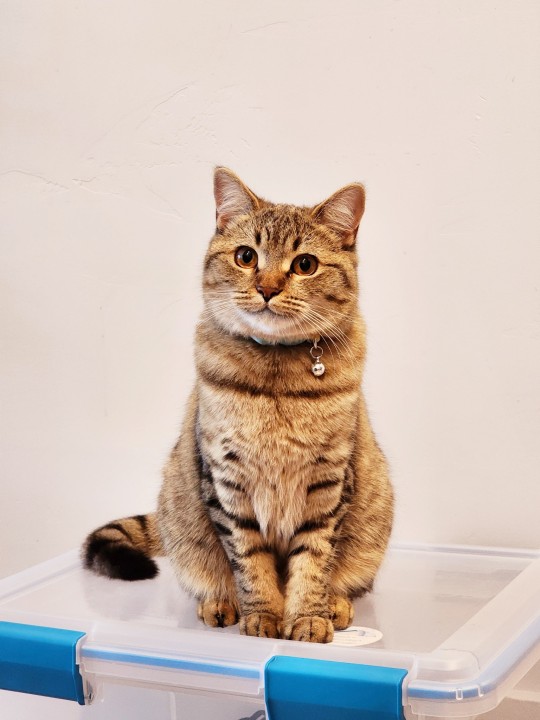
-------------------------------------------------
Did you know that there are over 200 cats in the Palace Museum/故宫博物院 in Beijing? Some of these cats were descendants of the pet cats of the imperial family hundreds of years ago, and some of these cats were simply strays, but they all found a home in the Palace Museum, and are now being fed and taken care of by the museum employees. You may even catch a glimpse of one of these cats during a visit to the museum.
Here are two of these cats, Jixiang/吉祥 (right; name means “auspicious”) and Ruyi/如意 (left; name means “(may things go) according to (one’s) wishes”)

Speaking of the Old Palace and royal kitties, cats actually have a fairly long history of being mousers and human companions in China, and sometimes they were even seen as powerful spirits to be both worshipped and feared.
Cats As Guardian Spirits
According to archaeological evidence, in China, cats came into people’s lives as early as 5300 years ago (~3300 BC). People of the Neolithic Yangshao Culture/仰韶文化 (~5000 - 3000 BC) in what is now central China grew millet, rice, and vegetables. These crops were bound to attract small rodents like mice and rats to human villages, which attracted wild cats in turn. There were no evidence showing that these wild cats had any sort of special or intimate bond with humans yet, so the relationship was likely a simple mutualistic relationship in which cats benefitted from having a steady source of prey, while humans benefitted from having their harvest protected from rodents. In the Book of Rites/《禮記》, a book detailing Zhou dynasty (1046 - 256 BC) etiquettes, administration, and ceremonial rites, there was a passage on the religious aspect of this mutualistic relationship:
“The wise and gentle rulers of yore will always repay the good deeds that others have done for them. Welcome the cats, for they are hunters of mice; welcome the tigers, for they are hunters of boars; welcome them and worship them”. (“古之君子,使之必報之。迎貓,為其食田鼠也;迎虎,為其食田豕也,迎而祭之也 。”)
-- Book of Rites, The Great Suburban Sacrificial Rites chapter (《禮記·郊特牲》).
As we can see in this short passage, people in ancient China regarded cats as spiritual beings--one of eight important animal spirits worshipped in the great ritual at the end of the year that must be performed by the ruler--and made offerings to them as a way to thank them for controlling rodent populations in the fields and protecting the year’s harvest.
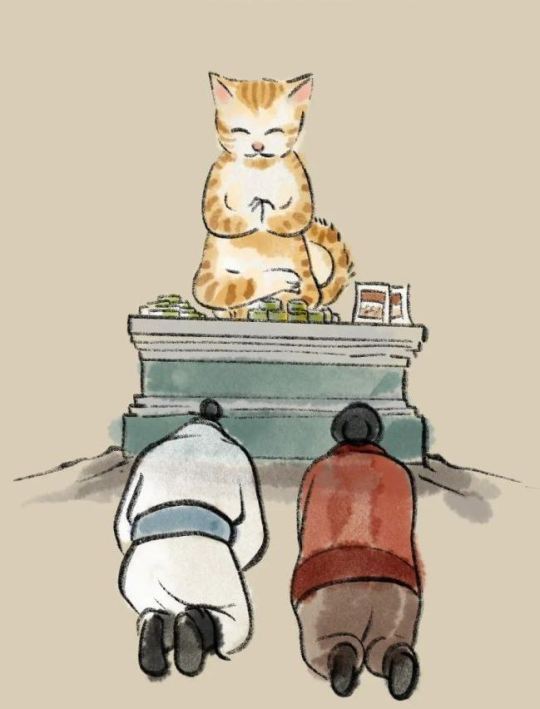
^ Illustration by 国馆 on Zhihu.
Cats as Evil Ghosts
In ancient folk belief, however, cats eventually became associated with wugu/巫蛊, which can be generally understood as “witchcraft” or “black magic”. Practitioners would sacrifice cats and keep “cat ghosts”/猫鬼, then send them out to curse whoever they wish to harm and steal money from. There was one famous case of this during Sui dynasty (581 - 618 AD) that was recorded in Book of Sui /《隋書》, the traditional official historical records of Sui dynasty that was completed in 636 AD. As the chapter “Consort Kin” (《隋書·外戚》) described, when Empress Dugu and Head of Secretariat Yang Su’s wife fell ill, the doctors diagnosed their illnesses as “caused by cat ghosts”. Emperor Wen of Sui/隋文帝 (personal name Yang Jian/楊堅) assumed that Dugu Tuo/獨孤陀 was behind the mysterious illnesses since Dugu Tuo was the paternal half-brother of Empress Dugu and his wife was the paternal half-sister of Yang Su, but Dugu Tuo denied having anything to do with it. So his household was questioned, and finally one of his housemaids confessed to be a practitioner of “witchcraft” and that she had cursed Empress Dugu and Yang Su’s family with her cat ghost under orders from Dugu Tuo. Dugu Tuo was stripped of all his titles along with his wife, and both were demoted to commoner status. So as we can see it was big enough in folk belief that it actually made its way into some imperial family drama. After this event, Emperor Wen of Sui declared a ban on these practices that were meant to cause harm to others.

^ A modern illustration of a “Cat ghost”, from the work titled Hundred Ghosts of China/《中国百鬼录》.
Cats in Analogies and Folklore
Cats have also been used in the classic cat-and-mouse analogies in different situations. During Wu Zetian/武則天’s ascent to power in Tang dynasty in 655 AD, she was involved in a power struggle with Empress Wang and Consort Xiao, and after some back-and-forths, Empress Wang and Consort Xiao were demoted to commoner status and imprisoned. Consort Xiao then cursed Wu Zetian, saying:
“May you become a mouse and I a cat, so I can choke you!” (”願阿武為老鼠,吾作貓兒,生生扼其喉!”)
-- Old Book of Tang, ”Empresses and Consorts Part 1”/《舊唐書· 后妃上》
Apparently after this happened, Wu Zetian banned cats from the palace out of fear.
Another example of this cat-and-mouse analogy was the memorial Su Shi/蘇軾 submitted to Emperor Shenzong of Song/宋神宗 (personal name Zhao Xu/趙頊) that argued against the parts of the reform proposed by Wang Anshi/王安石. This memorial was preserved and later named《上神宗皇帝書》. In it, Su Shi argued that government officials must be able to freely object another official’s proposal in order to prevent treacherous officials from gaining too much power with this analogy:
“We keep cats in order to keep mice at bay, but we cannot keep cats who can’t catch mice just because there are no mice around; we keep dogs in order to keep burglars away from our homes, but we cannot keep dogs that don’t bark just because there are no burglars around”. (”然而養貓所以去鼠,不可以無鼠而養不捕之貓。畜狗所以防奸,不可以無奸而畜不吠之狗”)
There weren’t only cat-and-mouse analogies, however. There's a short fable about cats and tigers that was passed down through the generations from at least Song dynasty all the way to the present day. Even I have heard of this story as a child. In this fable, the tiger was initially very clumsy, so the tiger asked a cat to teach it how to hunt. The cat agreed and taught the tiger how to track down, stalk, pounce, and play with prey, but refrained from teaching the tiger about tree-climbing. The tiger eventually mastered the art of hunting, and one day the tiger turned on its teacher, the cat, who then climbed atop a tree to save its own life. The moral of the story was either “never teach others everything you know, in case they use your knowledge against you”, or “never teach those who are ungrateful”, which resulted in the xiehouyu/歇后语 (a type of Chinese proverb) “cat teaching the tiger -- withhold some of your abilities” (“猫教老虎--留一手”). Of course, this fable doesn’t really stand in terms of scientific accuracy, seeing as tigers are proficient tree-climbers themselves, but the fable itself is still very interesting nonetheless. Although the origin of this fable has now faded into obscurity, the earliest record I could find was from the self-annotation on the poem “Mocking the Cats”/《嘲畜貓》 by the famous Song-era poet Lu You/陸游 in 1198 AD, which showed that this fable was already popular in folk culture in Southern Song dynasty:
“In folk belief cats were the uncles of tigers, they taught the tigers everything except how to climb trees”. (“俗言貓為虎舅,教虎百為惟不教上樹”)

^ Modern illustration of the fable, from children’s book The Tiger and the Cat by Eitaro Oshima.
Historical texts showed that at least from Southern and Northern dynasties (420 - 589 AD) and on, most people kept cats for their ability to catch mice, and oftentimes keeping cats as just house pets was something that was still limited to royalty, nobility, and rich people. But as we would see in Part 2, there were evidence from Song dynasty that showed a definite change in how cats were viewed in the ordinary household.
(Part 2 Here!)
247 notes
·
View notes
Text
Acorn is a wheat fiend! I give him 3 different varieties of wheat on a regular rotation, plus sorghum, millet, and various other grain/seed sprays. Flax seed seems to be his favorite, specifically the stuff imported from Ukraine. He's been sampling various fresh foods too. So far he has tried:
Broccoli
Pear
Green pepper
Parsley (partial interest, depends on his mood)
Banana (zero interest)
He also suddenly likes his pumpkin freeze-dried tofu blocks, which he didn't care for the first few months after he came home. He doesn't care for wild oat sprays, but he does like dried pressed oat flakes. He vacuums those up whenever I leave a pile for him. He also suddenly doesn't check the food mix in his bowl as much these days. However, the moment that I take food out of the bowl and sprinkle it around the cage, or hide it in small piles in paper towel tubes, it's interesting and tasty again.
Tiny hamster logic ¯\_(ツ)_/¯
26 notes
·
View notes
Text
Green Millet Manufacturer in India: Nourishing the Nation's Health with Euro Sun India
In the heartlands of India, where agriculture is not just a livelihood but a way of life, Euro Sun India stands tall as a prominent Green Millet Manufacturer in India. This company has not only become a beacon of quality but also a key player in the agricultural landscape of the country. Let's delve into the journey of Euro Sun India, a leading name in the Green Millet industry, exploring its role as a Supplier, Exporter, Wholesaler, and Trader in Rajasthan.

Green Millet Supplier in India: Cultivating Quality from Farm to Table
As a Green Millet Supplier in India, Euro Sun India prides itself on its commitment to delivering the finest quality millets to its customers. With a meticulous approach to farming, harvesting, and processing, the company ensures that the nutritional richness of green millets is retained at every stage. The stringent quality control measures in place make Euro Sun India a trusted partner for those seeking premium Green Millets in the Indian market.
Green Millet Exporter in India: Sharing Nutritional Wealth Globally
Beyond the borders of India, Euro Sun India has established itself as a reliable Green Millet Exporter. The company's dedication to maintaining international quality standards has enabled it to carve a niche in the global market. Through strategic partnerships and a robust supply chain, Euro Sun India exports its superior quality Green Millets to various corners of the world, contributing to the global demand for nutritious and wholesome grains.
Green Millet Wholesaler in Rajasthan: Nourishing the State with Euro Sun India's Bounty
In the vibrant state of Rajasthan, Euro Sun India serves as a Green Millet Wholeseller in Rajsthan, catering to the diverse needs of the local market. The rich agricultural heritage of Rajasthan finds a worthy companion in Euro Sun India's commitment to providing high-quality Green Millets. The company's extensive distribution network ensures that the nutritional benefits of millets reach every corner of the state, promoting a healthier lifestyle for the residents of Rajasthan.
Green Millet Trader in Rajasthan: Facilitating Agricultural Prosperity
As a Green Millet Trader in Rajsthan, Euro Sun India plays a pivotal role in the agricultural economy of the region. By connecting farmers with markets, the company contributes to the prosperity of local communities. Euro Sun India's fair trade practices ensure that farmers receive due recognition and remuneration for their efforts, fostering a sustainable and mutually beneficial relationship in the agricultural supply chain.
Cultivating Success: Euro Sun India's Approach to Green Millet Production
Euro Sun India's success as a Green Millet Manufacturer, Supplier, Exporter, Wholesaler, and Trader can be attributed to its holistic approach to agricultural practices. The company emphasizes sustainable and eco-friendly farming methods, minimizing the environmental impact of its operations. By investing in modern technology and research, Euro Sun India constantly innovates to enhance the nutritional value of its millets, contributing to the well-being of consumers.
The Nutritional Benefits of Green Millets
Incorporating Green Millets into one's diet brings a plethora of health benefits. These gluten-free grains are rich in fiber, vitamins, and minerals. They aid in digestion, regulate blood sugar levels, and promote cardiovascular health. Euro Sun India's commitment to quality ensures that consumers not only enjoy the delicious taste of Green Millets but also reap the numerous health advantages associated with these grains.
Conclusion: Euro Sun India - A Pillar of Green Millet Excellence
In the dynamic landscape of the Indian agricultural sector, Euro Sun India stands tall as a reliable and quality-driven Green Millet Manufacturer. From being a Supplier, Exporter, Wholesaler, and Trader in Rajasthan, the company has woven a tapestry of success, connecting farmers with consumers and contributing to the health and well-being of the nation. Euro Sun India's dedication to excellence, sustainability, and nutritional value makes it a shining example in the realm of Green Millet production and distribution. As we continue to prioritize health and well-being, Euro Sun India remains at the forefront, cultivating not just grains but a legacy of nourishment for generations to come.
Green Millet Supplier in India, Green Millet Exporter in India, Green Millet Wholesaler in Rajasthan, Green Millet Trader in Rajasthan – Euro Sun India is your trusted partner for quality and nutrition.
0 notes
Text
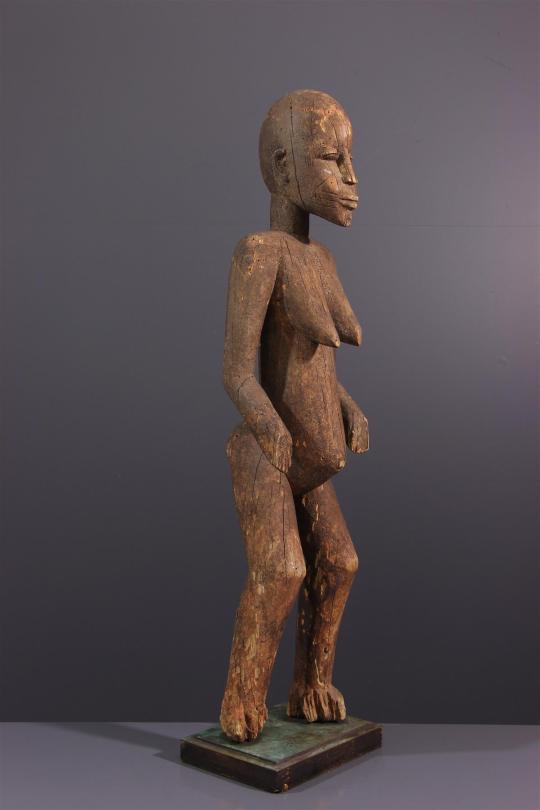
The Thila [Burkinese mythology; Lobi mythology]
At the dawn of time, the supreme deity Tangba You created the world. Tangba You fashioned the land, the seas, and then the humans to populate the world. But human men lusted after women and soon began fighting one another over the women, and the deity eventually grew tired of this. He was the creator god, after all, and we can assume he had better things to do than solve every petty issue among mortals. So he withdrew from the world of men, never again interfering with mortal affairs. Before leaving, however, Tangba You figured he should leave someone to guide and watch over humanity, so he created the Thila (singular: Thil): a group of semi-divine nature spirits.
This is the creation story of the Lobi people, who live in the north eastern parts of Côte d’Ivoire and south western Burkina Faso. They trace their roots back to Ghana.
The Thila play a very large role in traditional Lobi religion. These spirits are not really gods in the common sense of the word, but they are somewhat similar to the angels of Abrahamic religion (but note that they are sometimes described as ancestor spirits). They offer protection to the people, but also tell them how they should act. Though normally invisible to mortal eyes, these beings take on the form of an animal or a human in the rare event that they do appear before people.
Normally though, a Thil communicates solely through a ‘Thildar’, which is a human diviner in direct contact with the spirits (the societal role of these people can be likened to shamans of some native American traditions). As per the rules of their religion, a Thildar is always male, and usually there are only one or two of these diviners in a community. Each Thildar stands in contact with his own group of Thila spirits, with whom he can communicate during a divination. He then relays the will of the Thila, which includes guidelines and taboos pertaining to all kinds of subjects, including how the people should dress, have sex, hunt animals, etc. Sometimes the spirits demand to hold great feasts or festive events, and sometimes they forbid certain practises. One example is the village of Korhogo (near Gaoua): the people living here stopped sleeping on mats made from millet stem, because a Thil once forbade it. Also noteworthy is that Thila sometimes demand that the Thildar takes up a specific profession, like becoming a smith or a doctor.

This may sound strict to outsiders, but Thila are kind and benevolent spirits. They receive offerings during special occasions such as births and weddings, and bestow rain and childbirth on humanity. Should the people break the taboos that the Thila enforce, however, they can wreak havoc upon a community.
These spirits are believed to reside in special religious wooden sculptures called ‘Bateba’, which are usually housed in shrines dedicated to that specific Thil. This is important, because the act of placing a Bateba on a shrine greatly enhances its spirit’s ability to manifest in this world, allowing it to protect the people against evil (such as evil warlocks). If a Thil wants a shrine, it will tell this to a Thildar, along with specific instructions of where and how the shrine should be built. Within Burkina Faso, the Lobi are actually renowned for their woodworking skills, and as such the Bateba tend to be impressive works of art.
Finally, I want to mention that there are different kinds of Thila spirits, and the distinction is easily visible in their Bateba carvings. Some examples:
Bateba Phula are humanoid figures with a stiff standing pose. They house regular Thila.
Bateba Ti Puo house protective spirits that defend against evil; they feature raised arms.
A Thil Dorka houses a particularly powerful variant of Thila. It is a humanlike statuette with two heads, referencing the spirit’s ability to watch multiple locations at the same time.
Sources:
Asante, M. K. and Mazama, A., 2008, Encyclopedia of African Religions, SAGE Publications, 920 pp.
Peek, P. M., 1991, African Divination Systems: Ways of Knowing, African Systems of Thought, Georgetown University Press, 230 pp., pages 98-99.
Harvey, G., 2014, The Handbook of Contemporary Animism (Acumen Handbooks), Routledge, 544 pp., page 68.
(image source 1: African Arts Gallery, lot 12963)
(image source 2: MutualArt)
48 notes
·
View notes
Note
I have a lovebird question and if you have any input I would be grateful. A few days ago my brother found a lost Fischer's lovebird in a park in NYC. It willingly came to him and was rescued without incident and appears healthy. Bro is looking for the owners and has booked a vet appt with an avian vet, and has the assistance of a neighbor with lovebird knowledge and supplies, the little guy is all set up in a good temporary cage with appropriate food and supervision (though he seems to be spoiled and will only eat millet so far). His cage is safe behind a firmly-shutting door in my brother's room.
The issue is that he seems to have strongly bonded with my brother already and is burrowing in his shirt and sleeping on him and doing all the sweet lovely things that usually (I think?) take a lovebird much longer to warm up to with their human. The bird is tolerant but indifferent of the other humans in the apartment. However, my brother has two young cats and we know bird/cat households are risky or even unethical unless the cats are older or otherwise unlikely/unable to care about a bird, like in your own case.
In your opinion, is separating the lovebird from my brother potentially harmful to the bird's mental or emotional health given the bond that has formed, or is rehoming him going to be okay? We care most about doing what is best for the bird, my brother would miss him obviously but the bird's long term health is what's important here. Thank you for any input you can provide.
Here's a bird tax:
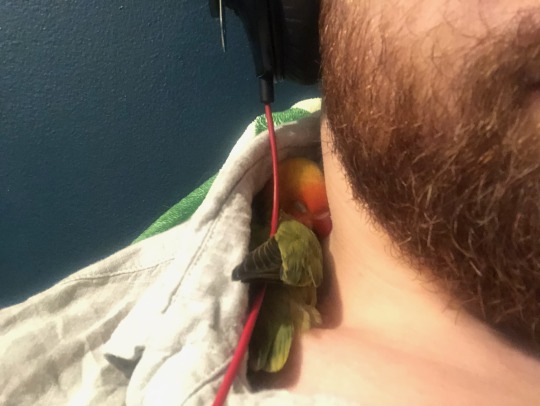
If you are unable to provide a safe and home then rehoming is definitely the better option, even if it causes emotional distress to the bird. No animal ever likes to be rehomed and it is true that birds are exceptionally emotional, but also sometimes it just has to happen. His new home should spend some extra time with him when they first get him because he may be "grieving" your brother, but frankly they should be doing that anyways to bond with him and because parrots are a highly social animal.
Obviously rehoming is a big deal and stressful for animals but it happens all the time. It happens even more often to parrots because they're long lived and a ton of work. Most of them, if they're going to a good home, end up just fine. It's not like this is your bird that you got bored of or something and are just getting rid of him because of that. You're just trying to do what is best for the little guy.
77 notes
·
View notes
Text


A miniature portrait of Jérôme Bonaparte by Louis François Aubry (French, 1767-1851)
Jérôme Bonaparte, King of Westphalia (1784-1860), wearing white uniform of the Westphalian Infantry and the red ribbon, star and badge of the Grand Eagle of the Légion d'Honneur.
Aubry was a pupil of Vincent and Isabey. In turn, he taught many important artists including Saint, Millet, Le Gros, Delacluze and Meuret. He painted many important members of the French court, including Jérôme and his wife, Pauline Bonaparte and the Empress Joséphine.
(Bonhams: Napoleon Bonaparte, The British Sale)
#Jérôme Bonaparte#Louis François Aubry#napoleonic era#napoleonic#Bonhams#auction#miniature#miniatures#the British sale#miniature portrait#portrait#Napoleon’s brothers#Jerome#jerome bonaparte#napoleon#first french empire#french empire#Westphalia#kingdom of westphalia#19th century art#Aubry
12 notes
·
View notes
Text

Ritual Vessel: Horse with Figures (Aduno Koro)
Dogon peoples, 16th–19th century
This monumental vessel was kept in the house of a lineage head in a Dogon community. It was used during an annual ritual known as "goru" to hold the offerings dedicated to Amma the Creator and the ancestors. Performed at the time of the winter solstice, the ceremony represents the culmination of rituals that celebrate the all-important millet harvest, whose abundance will support the family in the coming year.
Such works have been described as "aduno koro," an "ark of the world," meant to represent the mythic ark sent by Amma to reorganize and populate the world. The "aduno koro" displays a wealth of imagery relating to the Dogon account of genesis. Holding the eight original human ancestors and everything they needed for life on earth, the ark was guided by Nommo, the primordial being who created order within the universe. When the ark settled on the ground, Nommo transformed himself into a horse and transported the eight ancestors across the earth to water, where the ark floated like a boat.
13 notes
·
View notes
Note
A question?
shu from arknights is a 6-star defender belonging to the guardian defender archetype. she appears in the event "here a people sows" as the featured limited 6-star character alongside zuo le and is the 6th sibling of sui. her name "黍" means millet, more specifically referring to the broomcorn millet (panicum miliaceum) also known as common millet, proso millet, hog millet. it is one of the oldest cultivated and domesticated crops, domesticated for more than 10,000 years in northern china. it was essential to china as a crucial food staple and has cultural importance in events such as festivals and weddings.

10 notes
·
View notes